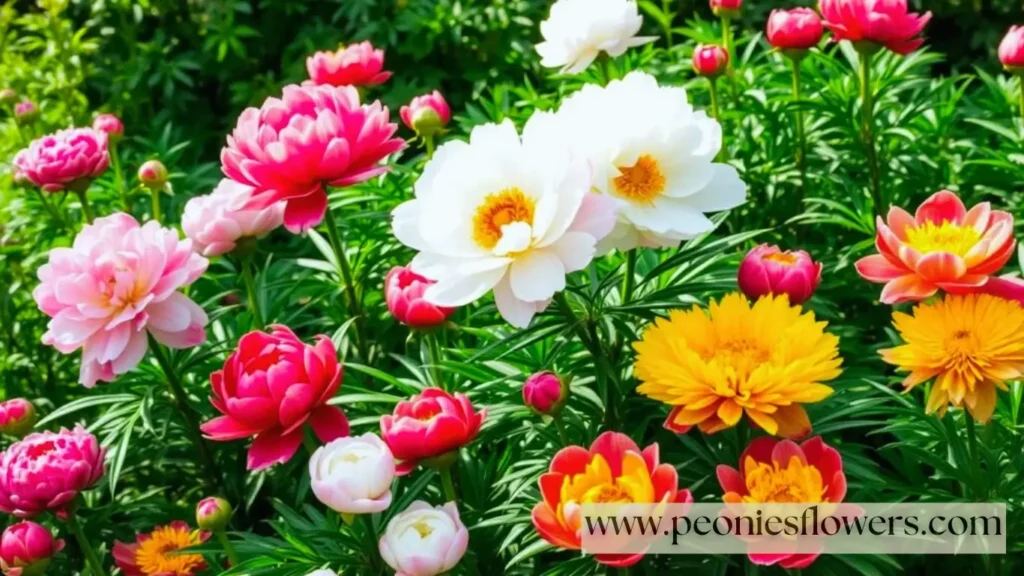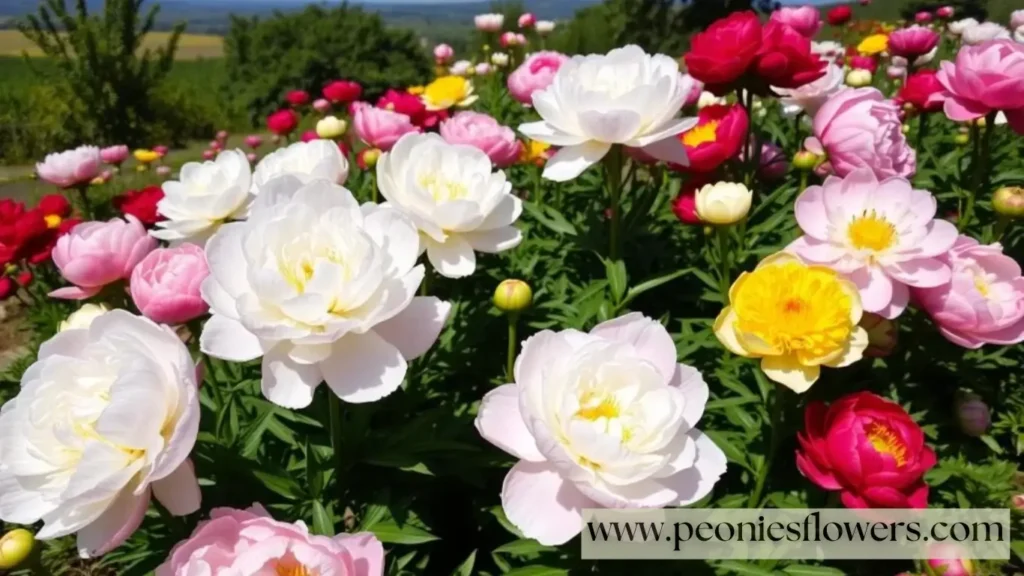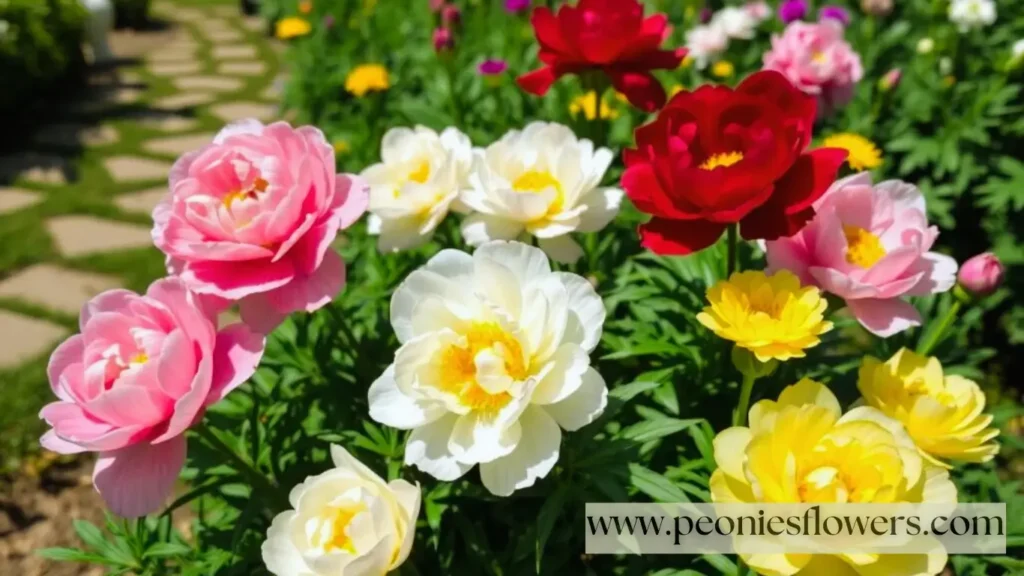Watching your garden come to life with colorful blooms is a joy. Peonies, with their lush flowers, are a favorite in many gardens. But picking the right peony varieties for your climate is key to their success.
In this guide, we’ll look at different peony types and what they need to grow well. Whether you’re new to gardening or have years of experience, this article will help you create a stunning peony garden.

We’ll explore herbaceous, tree, and intersectional peonies. Each has its special traits. Knowing about USDA’s hardiness zones and peony growing conditions will help you overcome any climate challenges.
Let’s start this journey together. We’ll find the perfect peonies for your garden. Together, we’ll create a beautiful display that will amaze and inspire you for years.
Understanding Climate Zones and Peony Growing Requirements
To choose the right peony varieties, you need to know your local climate and growing conditions. The USDA hardiness zones are key to finding the best peonies for your area.
USDA Hardiness Zones for Peonies
Peonies grow best in USDA hardiness zones 3 through 8. Some can handle colder or warmer temperatures. Knowing your zone helps pick the right peonies for your climate.
Essential Growing Conditions
Peonies need more than just the right zone. They require specific growing conditions for the best results. These include:
- Soil Type: They love well-drained, rich soil with a slightly acidic to neutral pH.
- Sunlight: Most need at least 6 hours of direct sunlight daily for growth and flowers.
- Water: They need consistent moisture, but can’t handle waterlogged soil.
Climate Challenges and Solutions
Peonies face different challenges in various climates. In warm, humid areas, they might get fungal diseases. In cold climates, late frosts can harm buds. By choosing disease-resistant varieties and protecting plants, you can help your peonies thrive.

Types of Peony Varieties for Different Regions
Choosing the right peonies for your garden depends on your area’s climate and soil. There are many types to pick from, like herbaceous, tree, and intersectional peonies. Each type does well in different places.
Herbaceous peonies are loved for their bright flowers and ability to grow back year after year. They do well in many climates, from cold northern states to warmer southern areas.
Tree peonies are great for places with mild winters and hot summers. They have strong stems and big flowers. These plants need a little extra care but are worth it for their beauty.
Intersectional peonies, or Itoh peonies, are a mix of herbaceous and tree peonies. They are very cold and hardy. This makes them perfect for gardeners in the north.
| Peony Type | Ideal Climate Zones | Popular Varieties |
|---|---|---|
| Herbaceous Peonies | USDA Hardiness Zones 3-8 | Sarah Bernhardt Karl Rosenfield Festiva Maxima |
| Tree Peonies | USDA Hardiness Zones 5-9 | Shin-Ryoku Hoki Renkaku |
| Intersectional Peonies | USDA Hardiness Zones 4-9 | Bartzella Julia Rose Cora Louise |
Knowing which peony types grow best in your area helps your plants bloom beautifully for years. This way, you can pick the perfect peonies for your garden.

Herbaceous Peonies: The Classic Garden Favorite
Peonies, especially the Paeonia lactiflora types, are a favorite in many gardens in the United States. They add beauty and variety to outdoor spaces. Whether you love the early, mid, or late blooms, there’s a peony for everyone.
Early Blooming Varieties
Early-blooming Paeonia lactiflora varieties are great for welcoming spring. Flowers like ‘Sarah Bernhardt’ and ‘Festiva Maxima’ bloom in late April or May. They bring color to your garden early.
Mid-Season Selections
When it gets warmer, peonies show their best with mid-season blooms. ‘Rainy Sun’ and ‘Shirley Temple’ have beautiful flowers in June and July. They’re the stars of the garden.
Late-Season Options
Late-blooming Paeonia lactiflora varieties offer a beautiful end to the season. ‘Lady Alexandra Duff’ and ‘Kansas’ bloom late into summer. They add elegance as the season ends.

No matter your climate or favorite bloom time, there’s a Paeonia lactiflora for you. They can make your garden even more beautiful and charming.
Tree Peonies: Growing Tips for Woody Varieties
If you love the big, beautiful blooms of Paeonia suffruticosa, you’re in for a treat. These tree peonies add elegance to any garden. To keep them happy, you need to know how to care for them.
Tree peonies have a special stem that stays green all year. This means they need a bit different care than other peonies. Here are the key tips for growing Paeonia suffruticosa well.
Climate Considerations for Tree Peonies
Tree peonies grow well in USDA Hardiness Zones 4 through 9. They like well-draining soil and full sun to partial shade.
Pruning and Winter Protection
Pruning is important for tree peonies. Do it in late winter or early spring. Cut out dead or damaged parts and thin out crowded stems.
In cold areas, protect them from winter by mulching or wrapping the stems.
Popular Tree Peony Cultivars
- ‘Feng Dan Bai’: A stunning white cultivar with large, fragrant blooms.
- ‘Luoyang Hong’: A vibrant red variety that is a standout in the garden.
- ‘Gentle Giant’: An impressive lavender-pink cultivar with a robust growth habit.
By knowing what Paeonia suffruticosa needs, you can make your tree peonies thrive. With the right care, they’ll be a beautiful highlight in your garden.
Intersectional (Itoh) Peonies: Best of Both Worlds
Gardeners looking for the best of both worlds find it in Itoh peonies. These hybrids mix the bright flowers and toughness of herbaceous peonies with the tree peony’s rich foliage and long-lasting blooms.
Popular Itoh Cultivars
Some top Itoh peony varieties include ‘Julia Rose,’ ‘Munched Candy,’ and ‘Bartzella.’ They come in a variety of colors, from soft pinks to bold yellows. Many have unique bicolor or streaked patterns.
Climate Adaptability Features
Itoh peonies are very adaptable to different climates. They can grow well in USDA Hardiness Zones 3-9. This makes them perfect for many areas. They also handle heat and humidity better than some other peonies.
Maintenance Requirements
Itoh peonies need some special care. They thrive in well-drained soil enriched with organic nutrients for optimal growth. They also need support, like staking or caging, to keep their stems upright.
Knowing how to care for Itoh peonies lets gardeners enjoy the best of both worlds. They can add beauty and variety to any garden.
Selecting Peonies Based on Bloom Time
Choosing the right peony varieties is crucial for a long-lasting garden bloom. Peonies bloom at different times, from early spring to late summer. This allows for a garden that’s always in bloom.
To make your garden bloom all season, it’s important to know when each peony blooms. Here are the options:
Early-Blooming Peonies
- These peonies bloom in late spring, usually in May or early June.
- Examples include ‘Sarah Bernhardt,’ ‘Festiva Maxima,’ and ‘Shirley Temple.’
Mid-Season Peonies
- These peonies bloom in the summer, extending the flower show into June and July.
- Popular mid-season picks include ‘Mme. Emile Debatene,’ ‘Red Charm,’ and ‘Karl Rosenfield.’
Late-Blooming Peonies
- These peonies bloom from July into August, ending the season.
- Consider ‘Paula Fay,’ ‘Bowl of Beauty,’ and ‘Krinkled White’ for a late-summer display.
Mixing early, mid, and late-season peonies allows you to have a garden full of color and scent all season. This way, your garden will be beautiful from spring to summer’s end.
| Peony Type | Bloom Period | Example Varieties |
|---|---|---|
| Early-Blooming | Late Spring | Sarah Bernhardt, Festiva Maxima, Shirley Temple |
| Mid-Season | Early-Mid Summer | Mme. Emile Debatene, Red Charm, Karl Rosenfield |
| Late-Blooming | Mid-Late Summer | Paula Fay, Bowl of Beauty, Krinkled White |
“Peonies offer gardeners a remarkable opportunity to create an extended flowering display by carefully selecting varieties with different bloom times.”
Color Selection and Fragrance Considerations
When picking peony varieties for your garden, think about color and scent. Peonies come in many colors, from bright reds and pinks to soft whites and pastels. You can choose from single-bloom or double-petal peonies, matching your style.
Single vs Double Blooms
Single peonies have a simple, elegant look. Double-bloom peonies, on the other hand, are full and fluffy. Both types are great for cutting and adding beauty to your home.
Fragrance Intensity Levels
Many peonies have a strong scent, ranging from light to intense. Choose fragrant peonies that match your scent preference. Some, like “Festiva Maxima,” have a strong smell. Others, like “Shirley Temple,” have a softer scent.
Color Combinations for Gardens
Peonies’ bright peony colors let you create amazing garden designs. Try pairing pink peonies with purple irises or white peonies with yellow daffodils. For a single-color look, group peonies in shades like reds and burgundies. Good garden design with peonies adds elegance to your outdoor space.
Care Tips for Your Climate-Specific Peony Varieties
Growing peonies need careful attention to their unique needs. This is especially true for climate-specific maintenance. Knowing the right care techniques is key to their health and longevity, whether you’re growing herbaceous, tree, or intersectional peonies.
Planting and Watering Peonies
Choose a spot with well-draining soil and lots of sunlight for planting peonies. Peonies flourish in full sun, requiring a minimum of 6 hours of direct sunlight each day. Make sure the planting depth is right, with the eyes (buds) no more than 2 inches below the soil.
Water your peonies often, especially in the hot summer. Try to give them about 1 inch of water per week, from rain or irrigation. Don’t overwater, as it can cause root rot and fungal diseases.
Fertilizing and Pruning Peonies
Apply a balanced, slow-release fertilizer to your peonies in early spring for optimal growth. Spread the fertilizer around the base of the plant, avoiding the foliage or stems. This gives them the nutrients they need for strong growth and beautiful blooms.
Prune the foliage after the plant has stopped flowering. Trim the stems back to the ground, removing any diseased or damaged leaves. This keeps the plant looking good and encourages new growth for next year.
Winter Protection for Peonies
In colder areas, peonies need extra care in winter. Mulch the base with 4-6 inches of organic material, like shredded bark or leaves, to keep the roots warm and prevent frost damage. Protect peony foliage from harsh winds and extreme temperatures by covering it with straw or burlap.
By following these climate-specific care tips, your peonies will thrive. They’ll give you stunning blooms season after season.
“Peonies are a few of the foremost fulfilling and long-lasting perennials for any cultivate, however, they require a bit of additional care to genuinely flourish.”
Growing Peonies for Cut Flower Production
If you want to grow cut flower peonies for sale, there are important things to remember. Choosing the right peony types, learning how to harvest, and taking good care of the flowers after picking are key. These steps can help your commercial peony-growing business thrive.
For cut flower peonies, some types are better than others. Look for varieties with strong, long stems. These can handle being cut and moved without damage. ‘Sarah Bernhardt’ and ‘Festiva Maxima’ are great because they have beautiful flowers and last a long time in vases.
It’s important to pick the right time to harvest your peonies. They should be cut when the buds are just starting to open. This is usually in the morning when the flowers are fresh and full of water. Taking good care of the stems after picking, like keeping them cool and hydrated, can also make your flowers last longer.
| Peony Variety | Stem Length | Bloom Size | Vase Life |
|---|---|---|---|
| Sarah Bernhardt | 18-24 inches | 6-8 inches | 7-10 days |
| Festiva Maxima | 20-26 inches | 7-9 inches | 8-12 days |
| Itoh Peony | 16-22 inches | 5-7 inches | 6-9 days |
By picking the right peonies, learning how to harvest them, and taking good care of them after picking them, you can make the most of cut-flower peonies. This opens up a whole new world in terms of growing commercial peonies.
Conclusion
Choosing the right peony varieties is crucial for a thriving garden. Knowing your USDA hardiness zone and growing needs helps. You can pick from classic herbaceous peonies, striking tree peonies, or versatile Itoh hybrids.
Try different peony types to make your garden stunning and diverse. Look for various colors, fragrances, and bloom forms. This way, you’ll find the perfect peonies that will impress everyone.
Start with the right peony varieties for your climate. Focus on peony variety selection, climate-adapted gardening, and peony cultivation success. This will help you enjoy these beautiful flowers in your backyard for years.
FAQ
What are the main types of peonies?
There are three main types of peonies: herbaceous, tree, and intersectional (Itoh). Each type has its look and growing needs.
How do I choose the right peony varieties for my climate?
It’s important to pick peonies that fit your USDA hardiness zone. Herbaceous, tree, and intersectional peonies each have their own climate needs. Make sure to research each type to find the best fit for your garden.
What are the essential growing conditions for peonies?
Peonies love well-drained, rich soil and full sun. They require at slightest 6 hours of coordinated daylight day by day. They also need enough water, but avoid standing water.
How do I choose peonies based on their bloom time?
Choose peonies that bloom at different times to have flowers all season. This way, you’ll enjoy peony blooms for longer.
What should I consider when choosing peony varieties for their color and fragrance?
Peonies come in many colors and fragrances. Think about what color and scent you want in your garden. Pick what you like best.
How do I care for my climate-specific peony varieties?
Care for your peonies based on their specific needs. This might mean adjusting how deep you plant them, how often you water them, and how you protect them in winter. This will help them grow well.
Can I grow peonies for cut flower production?
Yes, peonies are great for cut flowers. Look for varieties that last long in bouquets. Consider stem length and bloom size. Proper care after cutting will make your bouquets last longer.

1 thought on “Guide to Choosing the Right Peony Varieties for Your Climate”